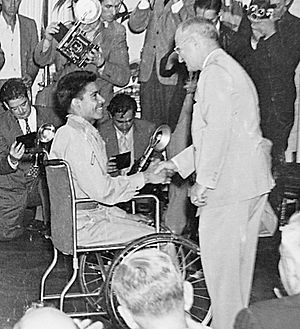Silvestre S. Herrera facts for kids
Quick facts for kids
Silvestre S. Herrera
|
|
|---|---|

PFC Silvestre S. Herrera, Medal of Honor recipient
|
|
| Born | July 17, 1917 Camargo, Chihuahua, Mexico |
| Died | November 26, 2007 (aged 90) Glendale, Arizona, US |
| Place of burial |
West Resthaven Park Cemetery, Glendale, Arizona
|
| Allegiance | United States |
| Service/ |
United States Army |
| Years of service | 1944–1946 |
| Rank | Sergeant |
| Unit | 2nd Battalion, 142d Infantry, 36th Infantry Division |
| Battles/wars | World War II |
| Awards | Medal of Honor Purple Heart Order of Military Merit (Mexico) |
Silvestre Santana Herrera (born July 17, 1917 – died November 26, 2007) was a brave soldier in the United States Army. He received the Medal of Honor for his amazing courage during World War II. This happened in Mertzwiller, France.
During a battle, Silvestre Herrera bravely attacked an enemy hideout by himself. He captured eight enemy soldiers. Later that day, his unit faced another machine gun nest across a dangerous minefield. Herrera, once again, went forward alone.
He stepped on two land mines, losing both of his legs. Even with severe injuries, he kept firing his M1 Garand rifle. His accurate shots kept the enemy pinned down. This allowed his friends to go around the minefield and capture the enemy position safely.
Silvestre Herrera was born in Mexico. He was the only person at the time of his death to have both the U.S. Medal of Honor and Mexico's Order of Military Merit. He is remembered as a hero in Arizona. A street in Phoenix, "S. Herrera Way," is named after him.
Contents
Silvestre Herrera's Early Life
Silvestre Herrera was born in Camargo, Chihuahua, Mexico. He thought he was born in El Paso, Texas until he was 27 years old. His parents died when he was only one year old. An uncle brought him to the United States for a better life.
Herrera worked on farms. He married his American wife, Ramona, and started a family in El Paso. They later moved to Phoenix, Arizona with their three children and his uncle. When the United States joined World War II, Herrera was called to serve in the Texas National Guard.
Just before leaving for the war, his uncle told him a big secret. He said Herrera was born in Mexico and was not a U.S. citizen. This meant he did not have to go to war. But Herrera still chose to go. He felt loyal to the country that had been good to him. He said, "I didn't want anybody to die in my place." He also had an American wife and children.
Heroic Actions in World War II

In the fall of 1944, Herrera's unit, the 142nd Infantry, arrived in Italy. They then moved to France. By early March 1945, they were near the front lines in the Alsace region.
On March 15, 1945, Herrera's unit was fighting in a forest near Mertzwiller, France. His group came under heavy machine gun fire. Most of the soldiers had to hide. Herrera bravely charged the enemy position alone. He fired his M1 rifle and threw two grenades. Eight enemy soldiers surrendered to him.
Later that same day, his group was attacked again. The new enemy position was protected by a large minefield. Herrera ignored the danger and charged forward by himself again. He wanted to draw the enemy's fire away from his friends.
A mine exploded, badly hurting one of his legs. He tried to stand on his other leg, but then stepped on a second mine. This caused him to lose his other leg below the knee. Even with these terrible injuries, Herrera kept firing his machine gun while kneeling. This allowed his friends to go around the minefield and capture the enemy position.
After his injuries, Herrera was in an Army hospital. On August 23, 1945, President Truman presented him with the Medal of Honor. Herrera rolled his wheelchair across the White House lawn for the ceremony. He later said that President Truman told him he would rather have the Medal of Honor than be president. This made Herrera even more proud.
More Honors for a Hero
A year after receiving the Medal of Honor, the Government of Mexico also honored Silvestre Herrera. They gave him their highest military award, the Order of Military Merit (First Class).
Herrera was the first person from Arizona to receive the Medal of Honor during World War II. Arizona Governor Sidney P. Osborn declared August 14, 1945, "Herrera Day." A parade welcomed him home as a hero. People in Arizona also raised $14,000 to buy him and his family a new home. He was also granted United States Citizenship.
Later Years and Legacy
In 1994 and 1999, Silvestre Herrera received awards from Valle Del Sol, Inc. On March 13, 1996, the United States House of Representatives honored him.
An elementary school in Phoenix, Arizona, is named after him: the Silvestre S Herrera School. On October 24, 1998, a U.S. Army Reserve Center in Mesa was also named in his honor.
Silvestre Herrera passed away on November 26, 2007, at his home in Glendale, Arizona. He was buried with full military honors in the West Resthaven Park Cemetery in Glendale. He rests next to his wife, Ramona, who died in 1991.
Awards and Decorations
| Medal of Honor | |
| Purple Heart | |
| American Campaign Medal | |
| European-African-Middle Eastern Campaign Medal | |
| World War II Victory Medal | |
| Mexican Order of Military Merit (First Class) |


